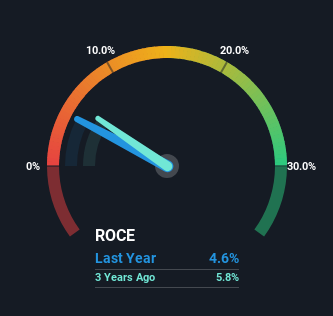- United States
- /
- Food
- /
- NasdaqGS:HAIN
Hain Celestial Group (NASDAQ:HAIN) Will Be Hoping To Turn Its Returns On Capital Around
What underlying fundamental trends can indicate that a company might be in decline? Typically, we'll see the trend of both return on capital employed (ROCE) declining and this usually coincides with a decreasing amount of capital employed. Basically the company is earning less on its investments and it is also reducing its total assets. And from a first read, things don't look too good at Hain Celestial Group (NASDAQ:HAIN), so let's see why.
Understanding Return On Capital Employed (ROCE)
For those that aren't sure what ROCE is, it measures the amount of pre-tax profits a company can generate from the capital employed in its business. Analysts use this formula to calculate it for Hain Celestial Group:
Return on Capital Employed = Earnings Before Interest and Tax (EBIT) ÷ (Total Assets - Current Liabilities)
0.046 = US$93m ÷ (US$2.3b - US$250m) (Based on the trailing twelve months to March 2023).
So, Hain Celestial Group has an ROCE of 4.6%. Ultimately, that's a low return and it under-performs the Food industry average of 9.7%.
View our latest analysis for Hain Celestial Group

In the above chart we have measured Hain Celestial Group's prior ROCE against its prior performance, but the future is arguably more important. If you're interested, you can view the analysts predictions in our free report on analyst forecasts for the company.
What Does the ROCE Trend For Hain Celestial Group Tell Us?
In terms of Hain Celestial Group's historical ROCE trend, it isn't fantastic. To be more specific, today's ROCE was 6.8% five years ago but has since fallen to 4.6%. On top of that, the business is utilizing 25% less capital within its operations. When you see both ROCE and capital employed diminishing, it can often be a sign of a mature and shrinking business that might be in structural decline. Typically businesses that exhibit these characteristics aren't the ones that tend to multiply over the long term, because statistically speaking, they've already gone through the growth phase of their life cycle.
The Key Takeaway
In short, lower returns and decreasing amounts capital employed in the business doesn't fill us with confidence. Investors haven't taken kindly to these developments, since the stock has declined 58% from where it was five years ago. That being the case, unless the underlying trends revert to a more positive trajectory, we'd consider looking elsewhere.
Hain Celestial Group does have some risks though, and we've spotted 1 warning sign for Hain Celestial Group that you might be interested in.
If you want to search for solid companies with great earnings, check out this free list of companies with good balance sheets and impressive returns on equity.
Valuation is complex, but we're here to simplify it.
Discover if Hain Celestial Group might be undervalued or overvalued with our detailed analysis, featuring fair value estimates, potential risks, dividends, insider trades, and its financial condition.
Access Free AnalysisHave feedback on this article? Concerned about the content? Get in touch with us directly. Alternatively, email editorial-team (at) simplywallst.com.
This article by Simply Wall St is general in nature. We provide commentary based on historical data and analyst forecasts only using an unbiased methodology and our articles are not intended to be financial advice. It does not constitute a recommendation to buy or sell any stock, and does not take account of your objectives, or your financial situation. We aim to bring you long-term focused analysis driven by fundamental data. Note that our analysis may not factor in the latest price-sensitive company announcements or qualitative material. Simply Wall St has no position in any stocks mentioned.
About NasdaqGS:HAIN
Hain Celestial Group
Manufactures, markets, and sells organic and natural products in the United States, United Kingdom, Europe, and internationally.
Undervalued with moderate growth potential.
Similar Companies
Market Insights
Community Narratives



